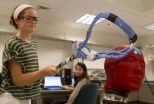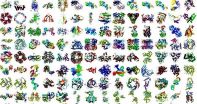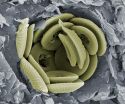(Press-News.org) December 1, 2014 - A study using intricate fiber dissection techniques provides new insights into the deep anatomy of the human brainstem--and helps to define "safe entry zones" for neurosurgeons performing brainstem surgery, according to a special article published in Operative Neurosurgery, a quarterly supplement to Neurosurgery, official journal of the Congress of Neurological Surgeons. These publications are published by Lippincott Williams & Wilkins, a part of Wolters Kluwer Health.
Neurosurgeons Dr. Kaan Yagmurlu and Dr. Albert L. Rhoton, Jr, of University of Florida, Gainesville, and colleagues performed fiber tract dissections, along with three-dimensional photography, to explore and document the complex anatomy of the brainstem. "We hope that the use of this knowledge will make surgical entry into the brainstem more accurate and safe," Dr. Rhoton and coauthors write.
Fiber Tract Dissections Guide Safe Routes for Brainstem Surgery
Working under the operating microscope, the researchers performed meticulous dissections of human brainstem specimens. They used a technique called fiber tract dissection, which traces the complex course of the nerve fibers that make up the brainstem. At each step of the dissection, 3-D photographs were obtained. In some areas, a magnetic resonance imaging technique called diffusion tensor imaging was used to help in visualizing the nerve fiber tracts.
The lowermost portion of the brain is directly connected to the spinal cord. The brainstem is involved in regulating some of the body's most basic functions. In addition to mapping and illustrating the inner anatomy of the brainstem, the researchers sought to identify the best surgical approaches to specific brainstem areas.
In their article, Drs. Yagmurlu and Rhoton and colleagues present richly detailed descriptions and 3-D images of the fiber tract anatomy of the brainstem. They also propose a short list of "safe entry zones" for each of the three major portions of the brainstem: the midbrain, pons, and medulla.
For each area, the suggested routes include key anatomical landmarks for the neurosurgeon to follow. The fundamental principle is to pass through as little normal tissue as possible, while avoiding critical areas and tracts.
"The safest approach for lesions located below the surface is usually the shorter and most direct route," the researchers write. However, for some parts of the brainstem, a more circuitous approach is needed to reach the target while protecting essential functional areas.
Although previous studies have used fiber dissection techniques to examine safe entry zones to the brainstem, most have focused on the surface anatomy. The new study is the first to use these techniques to define and document the "complex internal architecture" of the brainstem.
Drs. Yagmurlu and Rhoton and coauthors note that their dissection study cannot account for the infinite variations in anatomy of the human brainstem--the use of neurophysiological monitoring and mapping remains crucial during surgery. However, by providing unprecedented descriptions and 3-D images of the inner anatomy of the brainstem, the researchers hope their work will help neurosurgeons in planning the best approach to microsurgical procedures for gliomas (brain cancers) and blood vessel malformations in each area of the brainstem.
INFORMATION:
Click here to read "Three-Dimensional Microsurgical Anatomy and the Safe Entry Zones of the Brainstem."
About Neurosurgery
Neurosurgery, the Official Journal of the Congress of Neurological Surgeons, is your most complete window to the contemporary field of neurosurgery. Members of the Congress and non-member subscribers receive 3,000 pages per year packed with the very latest science, technology, and medicine, not to mention full-text online access to the world's most complete, up-to-the-minute neurosurgery resource. For professionals aware of the rapid pace of developments in the field, Neurosurgery is nothing short of indispensable.
About Wolters Kluwer Health
Wolters Kluwer Health is a leading global provider of information, business intelligence and point-of-care solutions for the healthcare industry. Serving more than 150 countries worldwide, clinicians rely on Wolters Kluwer Health's market leading information-enabled tools and software solutions throughout their professional careers from training to research to practice. Major brands include Health Language®, Lexicomp®, Lippincott Williams & Wilkins, Medicom®, Medknow, Ovid®, Pharmacy OneSource®, ProVation® Medical and UpToDate®.
Wolters Kluwer Health is part of Wolters Kluwer, a market-leading global information services company. Wolters Kluwer had 2013 annual revenues of €3.6 billion ($4.7 billion), employs approximately 19,000 people worldwide, and maintains operations in over 40 countries across Europe, North America, Asia Pacific, and Latin America.maintains operations in over 40 countries across Europe, North America, Asia Pacific, and Latin America. Wolters Kluwer is headquartered in Alphen aan den Rijn, the Netherlands. Its shares are quoted on Euronext Amsterdam (WKL) and are included in the AEX and Euronext 100 indices. Wolters Kluwer has a sponsored Level 1 American Depositary Receipt program. The ADRs are traded on the over-the-counter market in the U.S. (WTKWY).
Follow our official Twitter handle: @WKHealth.
Philadelphia, PA, December 1, 2014 - Panic disorder is a severe form of anxiety in which the affected individual feels an abrupt onset of fear, often accompanied by profound physical symptoms of discomfort. Scientists have known from studying twins that genes contribute to the risk of panic disorder, but very little is known about which specific genes are involved.
Two of the most common and terrifying symptoms of this severe anxiety are a sense of shortness of breath and feelings of suffocation. Studies have shown that breathing air that has increased levels of carbon ...
Mate choice is often the most important decision in the lives of humans and animals. Scientists at the Konrad Lorenz Institute of Ethology at the Vetmeduni Vienna have found the first evidence that birds may choose their mate through odor. They published their findings in Nature's Scientific Reports.
It has long been understood that reproducing with close relatives may have profoundly negative effects on offspring. It is therefore not surprising that biologists have discovered in some species that breeding individuals have evolved ways to detect their genetic similarity ...
Current data bases hold information on thousands of molecules--including drugs, natural substances, and chemical agents found in the environment-- that are associated with diseases, either because they have adverse effects or exert a therapeutic action. Using this information, gathered over many years and available in data bases, scientists headed by ICREA researcher Patrick Aloy at the Institute for Research in Biomedicine (IRB Barcelona) have devised a predictive model that allows them to associate chemical fragments with positive or negative effects in 20% of human ...
Athens, Ga. - Debunking the myth of the "mean girl," new research from the University of Georgia has found that boys use relational aggression--malicious rumors, social exclusion and rejection--to harm or manipulate others more often than girls.
The longitudinal study, published online in the journal Aggressive Behavior, followed a cohort of students from middle to high school and found that, at every grade level, boys engaged in relationally aggressive behavior more often than girls.
A team led by UGA professor Pamela Orpinas analyzed data collected from 620 students ...
PROVIDENCE, R.I. [Brown University] -- Lacrosse players swing hard, which is why errant stick blows are the leading cause of concussion in girls' and women's lacrosse. In a new study, researchers measured how much the worst blows accelerate the head and how much different kinds of headgear could reduce those accelerations.
Girls' and women's lacrosse is a different game from the version played by males, said Joseph Crisco, the Henry Frederick Lippitt Professor of Orthopaedic Research in the Alpert Medical School of Brown University and a researcher at Rhode Island Hospital. ...
A DRUG that could reduce the harmful side-effects of 'binge drinking', especially by teenagers, has been successfully developed and tested by a team of European scientists, including the University of Huddersfield's Professor Mike Page and Dr Karl Hemming. There is also the potential for new ways to treat Alzheimer's and other neurological diseases that damage the brain.
The key to the breakthrough is a compound developed by Professor Page and colleagues at the University of Huddersfield which is named ethane-beta-sultam. This is a taurine 'pro-drug' - an effective ...
Knowledge of the three-dimensional structures of proteins is essential for understanding biological processes.
Structures help to explain molecular and biochemical functions, visualize details of macromolecular interactions, facilitate understanding of underlying biochemical mechanisms and define biological concepts.
The human genome and follow-up sequencing projects have revolutionized biology and medicine; structural genomic programmes have developed and applied structure-determination pipelines to a wide range of protein targets, facilitating the visualization of ...
A study of ancient marine algae, led by the University of Southampton, has found that climate change affected their growth and skeleton structure, which has potential significance for today's equivalent microscopic organisms that play an important role in the world's oceans.
Coccolithophores, a type of marine algae, are prolific in the ocean today and have been for millions of years. These single-celled plankton produce calcite skeletons that are preserved in seafloor sediments after death. Although coccolithophores are microscopic, their abundance makes them key contributors ...
"A quantum computer may be thought of as a 'simulator of overall Nature," explains Fabio Franchini, a researcher at the International School for Advanced Studies (SISSA) of Trieste, "in other words, it's a machine capable of simulating Nature as a quantum system, something that classical computers cannot do". Quantum computers are machines that carry out operations by exploiting the phenomena of quantum mechanics, and they are capable of performing different functions from those of current computers. This science is still very young and the systems produced to date are ...
Subliminal visual cues are words, pictures or symbols which are unidentifiable in someone's conscious.
Conducted by Professor Samuele Marcora in collaboration with colleagues at Bangor University, the research discovered that athletes undergoing endurance exercise who were presented with positive subliminal cues, such as action-related words, including 'go' and 'energy', or were shown happy faces, were able to exercise significantly longer compared to those who were shown sad faces or inaction words.
The words and faces appeared on a digital screen - placed in front ...





